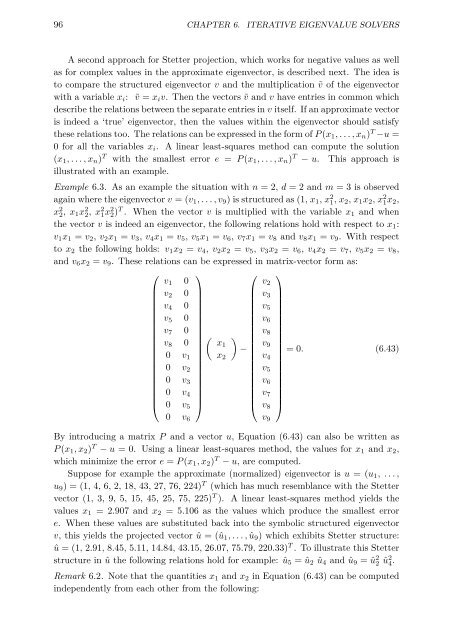link to my thesis
link to my thesis
link to my thesis
Create successful ePaper yourself
Turn your PDF publications into a flip-book with our unique Google optimized e-Paper software.
96 CHAPTER 6. ITERATIVE EIGENVALUE SOLVERS<br />
A second approach for Stetter projection, which works for negative values as well<br />
as for complex values in the approximate eigenvec<strong>to</strong>r, is described next. The idea is<br />
<strong>to</strong> compare the structured eigenvec<strong>to</strong>r v and the multiplication ṽ of the eigenvec<strong>to</strong>r<br />
with a variable x i : ṽ = x i v. Then the vec<strong>to</strong>rs ṽ and v have entries in common which<br />
describe the relations between the separate entries in v itself. If an approximate vec<strong>to</strong>r<br />
is indeed a ‘true’ eigenvec<strong>to</strong>r, then the values within the eigenvec<strong>to</strong>r should satisfy<br />
these relations <strong>to</strong>o. The relations can be expressed in the form of P (x 1 ,...,x n ) T −u =<br />
0 for all the variables x i . A linear least-squares method can compute the solution<br />
(x 1 ,...,x n ) T with the smallest error e = P (x 1 ,...,x n ) T − u. This approach is<br />
illustrated with an example.<br />
Example 6.3. As an example the situation with n =2,d = 2 and m = 3 is observed<br />
again where the eigenvec<strong>to</strong>r v =(v 1 ,...,v 9 ) is structured as (1, x 1 ,x 2 1,x 2 ,x 1 x 2 ,x 2 1x 2 ,<br />
x 2 2,x 1 x 2 2,x 2 1x 2 2) T . When the vec<strong>to</strong>r v is multiplied with the variable x 1 and when<br />
the vec<strong>to</strong>r v is indeed an eigenvec<strong>to</strong>r, the following relations hold with respect <strong>to</strong> x 1 :<br />
v 1 x 1 = v 2 , v 2 x 1 = v 3 , v 4 x 1 = v 5 , v 5 x 1 = v 6 , v 7 x 1 = v 8 and v 8 x 1 = v 9 . With respect<br />
<strong>to</strong> x 2 the following holds: v 1 x 2 = v 4 , v 2 x 2 = v 5 , v 3 x 2 = v 6 , v 4 x 2 = v 7 , v 5 x 2 = v 8 ,<br />
and v 6 x 2 = v 9 . These relations can be expressed in matrix-vec<strong>to</strong>r form as:<br />
⎛<br />
⎜<br />
⎝<br />
⎞<br />
v 1 0<br />
v 2 0<br />
v 4 0<br />
v 5 0<br />
v 7 0<br />
v 8 0<br />
0 v 1<br />
0 v 2<br />
0 v 3<br />
0 v 4<br />
⎟<br />
0 v 5<br />
⎠<br />
0 v 6<br />
(<br />
x1<br />
x 2<br />
)<br />
⎛<br />
−<br />
⎜<br />
⎝<br />
v 2<br />
v 3<br />
v 5<br />
v 6<br />
v 8<br />
v 9<br />
v 4<br />
v 5<br />
v 6<br />
v 7<br />
v 8<br />
v 9<br />
⎞<br />
=0. (6.43)<br />
⎟<br />
⎠<br />
By introducing a matrix P and a vec<strong>to</strong>r u, Equation (6.43) can also be written as<br />
P (x 1 ,x 2 ) T − u = 0. Using a linear least-squares method, the values for x 1 and x 2 ,<br />
which minimize the error e = P (x 1 ,x 2 ) T − u, are computed.<br />
Suppose for example the approximate (normalized) eigenvec<strong>to</strong>r is u =(u 1 , ...,<br />
u 9 )=(1, 4, 6, 2, 18, 43, 27, 76, 224) T (which has much resemblance with the Stetter<br />
vec<strong>to</strong>r (1, 3, 9, 5, 15, 45, 25, 75, 225) T ). A linear least-squares method yields the<br />
values x 1 =2.907 and x 2 =5.106 as the values which produce the smallest error<br />
e. When these values are substituted back in<strong>to</strong> the symbolic structured eigenvec<strong>to</strong>r<br />
v, this yields the projected vec<strong>to</strong>r û =(û 1 ,...,û 9 ) which exhibits Stetter structure:<br />
û =(1, 2.91, 8.45, 5.11, 14.84, 43.15, 26.07, 75.79, 220.33) T . To illustrate this Stetter<br />
structure in û the following relations hold for example: û 5 =û 2 û 4 and û 9 =û 2 2 û 2 4.<br />
Remark 6.2. Note that the quantities x 1 and x 2 in Equation (6.43) can be computed<br />
independently from each other from the following:

















